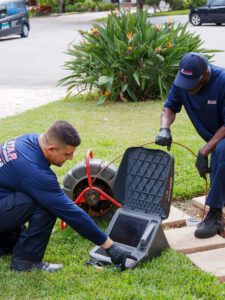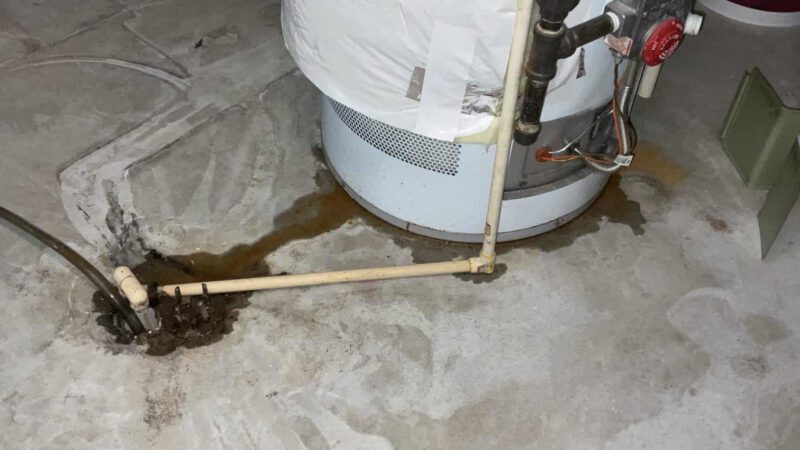DIY Sewer Cleaning: How to Get Rid of Clogged Drains and Sewer Lines
The drain pipes in a home connect to the main sewer line, which takes waste to a water treatment plant. Regular sewer cleaning prevents blockages and backups.
A nozzle is propelled from one manhole to another, and high-pressure water scours the inside of each pipe. Crews may also inspect the line with a camera for safety and compliance issues.
Clogged drains are one of the most common plumbing problems. If left unchecked, they can lead to messy and costly flooding and overflow of sinks, tubs, and toilets. The foul odor that usually accompanies a drain clog is another clear sign that it’s time to call in a professional.
Most drain clogs form when food, hair, debris, and waste build up inside the pipes. Grease, soap scum, and other organic matter also impede water flow. Luckily, there are several easy ways to prevent and fix clogged drains.
Start by removing any visible obstructions from the surface of the pipe. If that doesn’t work, try flushing the drain with hot water. Pour a kettle of boiling water down the drain in two or three stages, waiting a few seconds between each.
If the drain still isn’t working, use a chemical drain cleaner. But always follow the manufacturer’s instructions and protect yourself and your surroundings with proper safety equipment. Also, remember that chemical drain cleaners don’t work well in garbage disposals and may damage the inner surface of pipes.
A more permanent solution to clogged pipes is installing a drain interceptor, which is essentially a large trough that sits under the drain opening. It collects and holds waste until it’s emptied into the sewer system.
You can find these in most home improvement stores, and they’re relatively inexpensive.
Other permanent solutions to clogged pipes include having a plumber install a French drain, which is a trench that runs along the floor of your home and directs water and waste to the sewer system. You can also plant trees and shrubs far away from your house’s underground pipes to avoid tree roots growing into them.
Regularly inspect your home’s pipes for signs of a blockage, such as slow drainage or water backing up from sinks or toilets. A professional plumber will be able to help you resolve any serious drain issues before they turn into costly disasters. For example, a backed-up toilet can flood your home and contaminate the surrounding area with toxic materials like raw sewage or dead animals.
Grease and oil buildup
Grease is a major contributor to many sewer line problems. When it is poured down drains, it can solidify and coat the walls of pipes, restricting the flow of wastewater. Grease can also cause clogged toilets and bathtubs. It can even contaminate drinking water and create environmental hazards. Fortunately, there are several steps that can be taken to prevent and clean up FOG-related sewer backups.
Greasy foods should never be poured down kitchen sink drains or toilets. Instead, they should be poured into cans to cool and then disposed of in the trash. It is also important to clean up after cooking with oily and greasy foods by wiping up any excess grease on dishes before washing. In addition, sink strainers should be used to catch food scraps and keep them from going down the drains.
Regularly cleaning a grease trap or interceptor can also help keep it free from buildup. The most common way to clean a grease trap is to use hot water and a degreasing product. These products are available at most hardware and home improvement stores. Another option is to hire a professional to clean the grease trap with high-pressure water jets. This is the most effective method for removing large amounts of grease and can be done on a regular basis to keep the grease from building up in your sewer lines.
Fog buildup causes about 47 percent of the 36,000 sewage overflows that occur each year in the United States. These overflows can cause environmental problems, traffic tie-ups, and even flood homes and businesses. Preventing FOG buildup is not only environmentally responsible, but it can also save property owners money from costly repairs and cleanup costs.
A simple way to prevent grease clogs is to use an enzyme drain cleaner. These cleaners are formulated to break down grease and other organic waste that builds up in drain lines. These cleaners contain living bacteria that eat grease and other waste, keeping it from building up in your drain lines and sewer system. You can find enzyme drain cleaners at most hardware and home improvement stores.
Chemical Cleaners
A clogged drain can be a sign that your sewer line is in need of cleaning. If you notice strange smells coming from your drains, slow flushing of toilets, or water backing up into your home, it may be time to call a professional. However, before you do, try some of these simple DIY methods for clearing drains and sewer lines:
The most common cause of a clogged drain or sewer backup is the improper disposal of items down the drain. Many of these items—including diapers, string, paper towels, bandages, and grease—can become stuck in the lining of pipes and cause blockages.
Pouring liquid drain cleaner down your drains can often dissolve clogs quickly. However, it can also damage your plumbing system. Chemicals in these products can corrode or warp PVC pipes and cause holes in metal ones. If you must use a liquid drain cleaner, only do so in a well-ventilated area and follow the instructions on the label.
While these chemical products work well for most household clogs, they are not intended for use in your home’s sewer system. In addition to their health hazards, they can damage your pipes and contaminate the environment. If you have a persistent clog, talk to your plumber about more long-term solutions like the installation of a garbage disposal or a rooter drain.
Another way to clean your sewer line is to flush it with water. When you’re not dealing with a clog, simply put a little bit of drain cleaner into your drain and then flush it with hot water. This will clean the line and help prevent future clogs.
If you have a minor tree root intrusion, you can use special chemical cleaners to kill the roots and keep them from growing into your pipes again. These cleaners typically contain acid, caustic soda, or lye, which release heat to break down the clog and dissolve organic materials such as hair or grease. Some of these chemicals can also be dangerous for your pets and children, so it’s important to take proper safety precautions when using them.
Enzymes
Enzymes are protein molecules made by living cells that facilitate virtually every chemical reaction in the body. They are also produced by microorganisms, such as bacteria, to break down organic waste.
Unlike chemical drain cleaners that are highly corrosive and may damage piping, enzymes are non-corrosive and safe for pipes. They are also non-toxic to humans, pets, and the environment. These cleaners work to break down and liquefy organic residue that would otherwise clog drain lines, traps, and the septic tank. They are especially effective in eliminating odors and breaking down the buildup of soap scum and hair within drains, traps, and toilets.
A natural, biologically-based product that contains a strain of specialized bacteria, enzyme drain cleaners take advantage of the bacteria’s ability to digest a variety of materials, including oils, fats, proteins, starches, and cellulose. The active site of the bacterial strains is designed to match the specific molecules that make up waste buildup in residential and commercial drain lines, thereby breaking them down and liquefying them. This reduces or eliminates the need for mechanical cleaning or drain snaking.
The bacteria used in these products are able to survive and reproduce even when exposed to harsh chemicals. The resulting metabolites continue to breakdown waste throughout the plumbing system and in the septic tank. This is especially helpful in septic systems, where it can reduce the need for frequent pumping and extend the time between tank services.
When used as directed, enzyme products take a bit longer to start working than traditional chemical-based drain cleaners, usually needing to be applied over night. However, they are much safer for pipes and the environment and can often clear away gunk that years of chemical drain cleaners haven’t been able to do.
Another benefit of enzymatic drain cleaners is that they are safe to use in septic tanks and will not harm the beneficial bacteria already present there. Chemicals, on the other hand, will kill the septic tank’s natural bacteria and can lead to more frequent septic tank services. This can be a major cost savings for customers.


